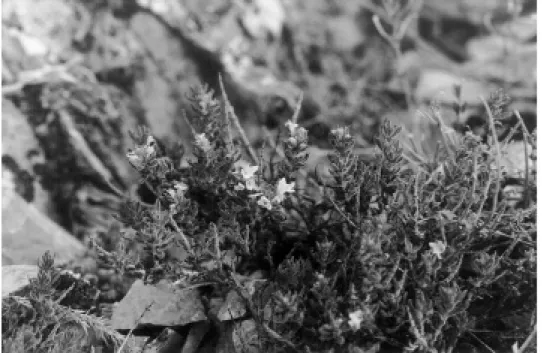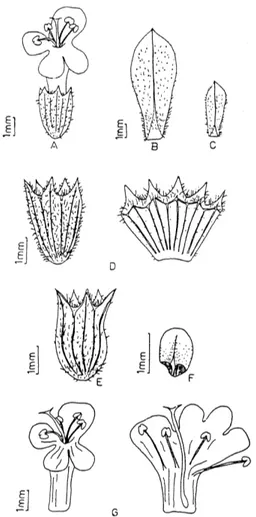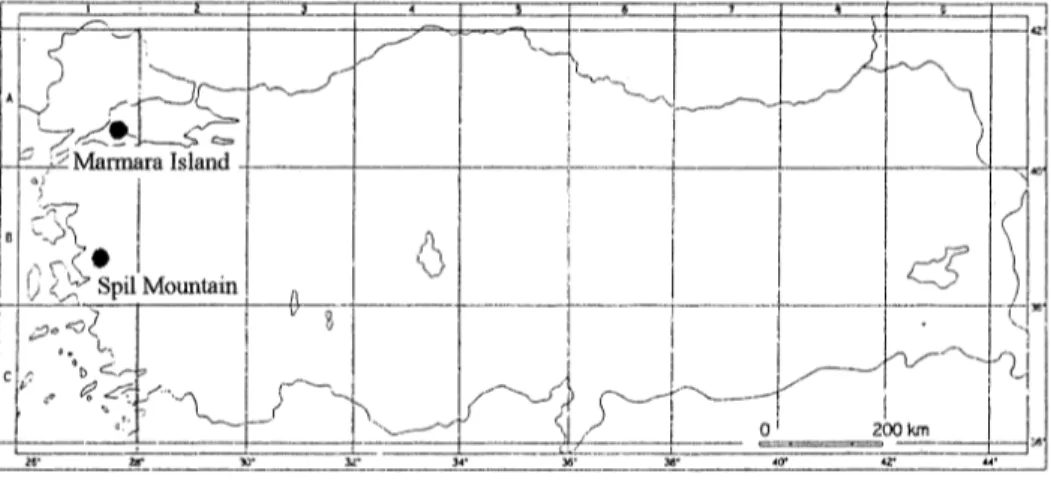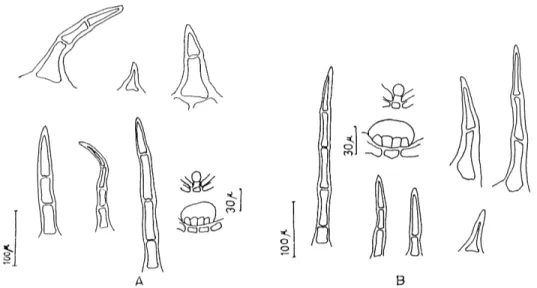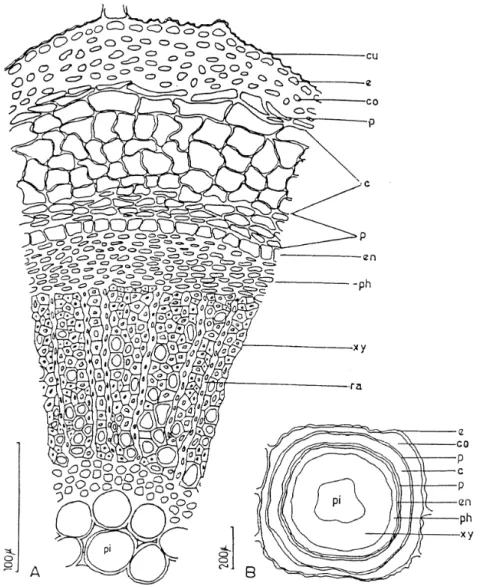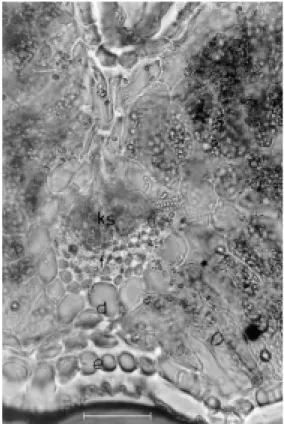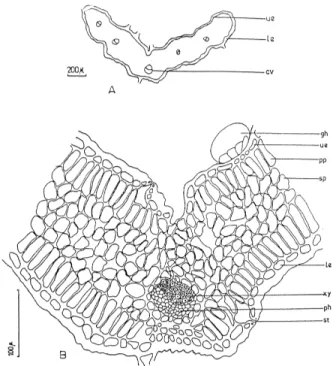Comparative morphological, anatomical, ecological
and chemical studies on endemic Satureja parnassica
subsp. sipylea from Turkey
FATIHSATIL1*, GÜLENDAMTÜMEN1, AHMETAKÇELIK1, KEMALHÜSNÜCAN
BAS¸ER2
1Bali•kesir University, Faculty of Science and Letters, Biology Department,
10100-Bali•kesir, Turkey
2Anadolu University, Medicinal and Aromatic Plant and Drug Research Centre (TBAM), 26470-Eskis¸ehir, Turkey
Satureja. parnassica Heldr.et Sart. subsp. sipylea P.H. Davis is a subspecies endemic to
Turkey. The anatomical, morphological, ecological and chemical features of S.
parna-ssica subsp. sipylea have been investigated. Plant samples were collected from different
regions in Turkey. The morphological features of various organs of the plant such as leaf and flower are described in detail. In anatomical studies, transverse sections of the plant stem and leaf have been examined and supported by illustration and photographs. Ecolog-ical studies provide information about the physEcolog-ical and chemEcolog-ical structure of soil types in Spil Mountain and Marmara Island. The chemical composition of the essential oil of ae-rial parts of the plant was examined.
Key words: Anatomy, morphology, ecology, essential oil, Lamiaceae, Satureja parnassica
Introduction
The genus Satureja (Lamiaceae) is distributed in an area stretching from the Mediterra-nean region to Europe, West Asia, North Africa, the Canary Islands and South America (HEGI1964, BAYTOP1991, STRIDand TAN1991).
Systematic studies on the genus Satureja are presented in various flora and publications (TUTINet al. 1972, FEINBRUN-DOTHAN1978, DAVISet al.1988, STRIDand TAN1991). The
first detailed information on the species of Satureja growing in Turkey was given in Flora Orientalis by BOISSIER(1879). The author described 15 species, 8 of which are distributed
in Turkey. Later, HAYEK(1931) provided some further information on Satureja species
col-lected in Turkey.
The genus Satureja consists of perennial herbs except for one species and is represented by 14 species in the flora of Turkey (DAVISet al. 1988). The number of Satureja species in
Turkey rose to 15 after a recent investigation in the Aegean and Marmara regions (TÜMEN
et al. 2000).
There have been very few studies on the morphology and anatomy of Satureja species in Turkey (KAYAet al. 1994) but the morphological and chemical features of Satureja
spe-cies collected from Thrace and West Anatolia were investigated by BAS¸ERet al. 2000.
This study was carried out in order to provide insight into the distribution, morphology, anatomy, ecology and chemical components of essential oils of Satureja parnassica subsp. sipylea from Marmara Island and Spil Mountain.
Material and Methods
S. parnassica subsp. sipylea was collected from Marmara Island in Balikesir and Spil Mountain in the Manisa province of Turkey in August 1996. Voucher specimens are depos-ited in the Herbarium of the Faculty of Pharmacy, Anadolu University in Eskis¸ehir Turkey (Acronym ESSE). Morphological features were determined on living and herbarium mate-rials. Approximately thirty specimens were used to determine the morphological character-istics. Transverse sections and surface preparations of stem and leaves were made manu-ally for anatomical studies. A Wild M5 stereomicroscope with drawing tube and a Nikon Eclipse E 600 research microscope were used in morphological and anatomical studies.
The soil samples were collected from the localities between July and August at a depth of between 0–20 cm. The texture, total salt, CaCO3, pH, P2O5Kg/dk, K2O Kg/dk and or-ganic matter were determined.
Essential Oil Distillation
The aerial parts of the air-dried plants including the inflorescence were subjected to wa-ter distillation for 3 h using a Clevenger apparatus to yield essential oils.
Gas Chromatography / Mass Spectrometric (GC/MS) Analysis
The oils were analyzed by GC/MS using a Hewlett Packard GCD system. An Innowax FSC column (60 m ´ 0.25 mm f, with 0.25mm film thickness) was used with helium as car-rier gas (1 ml min–1). The GC oven temperature was kept at 60 °C for 10 min and pro-grammed to 220 °C at a rate of 4 °C min–1, then kept constant at 220 °C for 10 min and then programmed to 240 °C at a rate of 1 °C min–1. Alkanes were used as reference points in the calculation of relative retention indices (RRI). Split ratio was adjusted at 50:1. The injector temperature was at 250 °C. MS were taken at 70 eV. Mass range was from 35 to 425 m/z. Li-brary search was carried out using the Wiley GC/MS LiLi-brary and TBAM LiLi-brary of Essen-tial Oil Constituents. Relative percentage amounts were calculated from TIC by the com-puter.
Results
Morphological Studies
Satureja parnassica Heldr.et Sart. subsp. sipylea P.H.Davis
The species was first described by Boissier in Fl. Or. 4:563 (1879) and the subspecies by Davis in Notes R.B.G. Edinb. 38:52 (1980). Small shrub, 6–16 cm long. Root with stout woody stock. Stem 1–4 cm diameter, woody at base, much branched from basal part to up-wards, terete, bark dark brown, falling off in small pieces (Fig. 1). Upper stem densely pat-ent hirsute all round, hair 0.2–0.6(–4) mm, especially longest near nodes (4–6 mm). Leaf-less below, densely leafy above. Cauline leaves greyish-green, cuneate-oblanceolate, outer leaves big in size, 7.5–14 ´ 2.5–4.5 mm, inner leaves small, 2.5–8 ´ 1–3 mm, sessile, entire, strongly mucronate, cuneate-oblong at base, without visible lateral veins beneath, densely hispidulous-pubescent on both surfaces, especially dense, hirsute long hairs at base, oil dots numerous, embedded in both surfaces, usually red. Floral leaves spathu-late-oblanceolat, 4.5–7.5 ´ 0.5–1.5 mm, sessile, strongly mucronate, as long as 1–1.5 ´ the length of calyx, entire, cuneate at base, scabrid-pubescent, long hirsute hairs at base, sparsely glandular hairs with stalk on both surfaces (S. parnassica which is the only species having glandular hairs with stalk in floral leaves). Bracteoles (1.5)2–3(–3.2) mm, not lon-ger than ½ calyx, sometimes as long as the calyx. Inflorescence not long, 1.5–3.5 cm, verticillasters gradually becoming dense towards apex 3–9, 2-flowered, petiole to 8 mm.
Calyx greyish-green, (2.5)3–3.5(–4) mm, subactinomorphic, gamocephalous, slightly
bi-labiate, 10 veins, five teeth, teeth 1–1.5 mm, lanceolate. 1/3–1/2 calyx, outer scabrid-hir-sute, glandular, inner dense hirsute in teeth. Corolla white, exserted calyx, 4–4.5 mm,
tubulate, gamopetalous, bilabiate, upper lip erect and large, apex obtuse, sometimes bifid, lower lip 3-lobed, margin slightly undulate, dense pubescent, sparsely glandular outside, short pubescent inside. Stamens 4, didinamous and exserted from upper lip, anthers pur-ple, 0.4–0.8 mm, dorsifix, filaments white (1.5–2)–6.5 mm, style white, 4.5–8 mm, gyno-basic, subulate, exserted from corolla. Nutlets light brown, 0.8–1.2 ´ 0.6–0.9 mm, obo-vate-oblong, apex obtuse, pubescent-glandular (Figs. 2, 3).
Distribution
Type: Turkey, B1 Manisa: Spil Mountain, 16.07.1854, Balansa 309 (holotype Kew Herbar-ium, isotype British Museum, Geneva Herbarium – S. spinosa)(Fig. 4).
Turkey, A1 Bali•kesir: Marmara Island, above Çi•narli•köy, 600 m, E. Tuzlaci•(ISTE 38783)!
Fig. 2. Satureja parnassica subsp. sipylea (Mar-mara Island): A-Flower, B-Leaf, C-Brac-te, D-Calyx, E-Fruiting calyx, F-Nutlet, G-Corolla
Fig. 3. Satureja parnassica subsp. sipylea (Spil Mountain): A-Flower, B-Leaf, C-Brac-te, D-Calyx, E-Fruiting calyx, F-Nutlet, G-Corolla
Turkey, A1 Bali•kesir: Marmara Island, Çi•narli•köy 150 m, 30.08.1996, T. Dirmenci, F.
Sati•l 1039.
Turkey, B1 Manisa: Spil Mountain, fire
tower, 1500 m, 31.08.1996, F. Sati•l, G.
Tümen 1040 (Fig. 4).
Anatomical Studies
Stem: Transverse sections taken from
the middle part of the stem (annual) were observed as follows (Figs. 5–9): The epi-dermis is composed of a single layer of cells, and covered with a thick and undula-ted cuticle containing glandular and eglan-dular hairs. Eglaneglan-dular are more common than glandular hairs. Covering trichomes are usually multicellular (1–5) and covered with a thin cuticle. Unicellular hairs are rare. Two types of glandular hairs are en-countered; head and stalk unicellular, and Labiatae type (Fig. 7A). The collenchyma tissue, located immediately under the epi-dermis, is 4–6-layered on the corners and 1–3-layered in between the corners. Paren-chyma tissue is 2–5-layered and usually squashed. Single layered endodermis con-sists of rectangular cells and is absent place to place. There is a 4–5-layered cork tissue above the endodermis. The pericycle is
in-Fig. 4. Map showing the distribution of Satureja parnassica subsp. sipylea (
·
)Fig. 5. Satureja parnassica subsp. sipylea (Mar-mara Island): Cross-section of stem. k-cuticula, e-epidermis, ko-kollenchy-ma, m-cork, p-parenchyko-kollenchy-ma, en-endo-dermis, f-phloem. Bar = 20 mm
distinguishable. Phloem is 6–8-layered, cells pressed and squared. The cambium is also not distinguishable. The xylem comprises of tracheas and tracheids. The tracheas are orbicular or ovoid while tracheids are poly-hedral. The xylem forms a large ring divided with uniseriate rays. The pith con-sists of large orbicular or polyhedral pa-renchymatous cells and the centre of pith often breaks into pieces (Figs. 8, 9).
Leaves: Transverse sections of the leaf
lamina (Figs. 10–13) and the midrib and surface preparations of both the epidermis layers (Fig. 7B) revealed the following ele-ments.
In transverse section upper and lower epidermis comprise uniseriate square and rectangular cells. Outside walls are thicker than internal and lateral walls. Both epider-mis are covered with a thick undulate cuti-cle. There are dense glandular and eglan-dular hairs on the surfaces of both epider-mis. The covering eglandular trichomes are 1–5-cellular. Unicellular hairs are usually on the lateral side of leaf. There are two types of glandular hairs; Labiatae type and
Fig. 6. Satureja parnassica subsp. sipylea (Spil Mountain): Cross-section of stem. s-glan-dular hair, öt-eglans-glan-dular hair, ko-collen-chyma, m-cork, f-phloem, ks-xylem. Bar = 20 mm
head and stalk unicellular type (Fig. 7B). They are embedded in the surfaces of both epider-mal layers. Stomata type is diacytic (METCALFEand CHALK1979) and occurs on the
sur-faces of both epidermal layers, being more abundant on the lower surface. Stomata are lo-cated almost on the same level as teh epidermal cells. The leaf is isolateral. Mesophyll occurs as 1-seriate palisade tissue under both epidermises and 2–4-seriate spongy paren-chyma in between. Both parenparen-chyma tissues contain starch and ergastic substance. The central vessel is better developed than the lateral vessel. As expected, the xylem faces the upper surface while the phloem faces the lower epidermis. Vascular bundles are sur-rounded by parenchymatous bundle sheathings (Figs. 10, 12, 13).
Fig. 8. Satureja parnassica subsp. sipylea (Marmara Island) A–B) Cross-section of stem, cu--cuticula, e-epidermis, co-collenchyma, p-parenchyma, c-cork, en-endodermis, ph-phloem, xy-xylem, ra-rays, pi-pith.
Ecological Characteristics:
S. parnassica subsp. sipylea grows on exposed limestone rocks and stony slopes. It shares a habitat with Quercus sp., Sideritis sp., Salvia sp., Thymus sp. and Gramineae sp.
Flowering period: August-October.
The results of the soil analysis collected from suitable habitats for S. parnassica subsp. sipylea are given in Table 1.
Fig. 9. Satureja parnassica subsp. sipylea (Spil Mountain) A–B) Cross-section of stem, cu-cuticula, e-epidermis, co-collenchyma, p-parenchyma, c-cork, en-endodermis, ph-phloem, xy-xylem, ra-rays, pi-pith.
Fig. 10. Satureja parnassica subsp. sipylea (Marmara Island): Cross-section of leaf ks-xylem, f-phloem, d-bundle sheath, e-epidermis. Bar = 50 mm
Fig. 11. Satureja parnassica subsp. sipylea (Spil Mountain): Cross-section of leaf ks-xylem, sk-sclerenchyma, f-phloem. Bar = 50 mm
Fig. 12. Satureja parnassica subsp. sipylea (Marmara Island): A–B) Cross-section of leaf, ue-upper epidermis, le-lower epidermis, cv-central vessel, gh-glandular hair, pp-palisade paren-chyma, sp-spongy parenparen-chyma, xy-xylem, ph-phloem, st-stomata
Fig. 13. Satureja parnassica subsp. sipylea (Spil Mountain): A–B) Cross-section of leaf. ue-upper epidermis, le-lower epidermis, cv-central vessel, st-stomata, pp-palisade parenchyma, sp-spongy parenchyma, xy-xylem, sc-sclerenchyma, ph-phloem
Chemical Characteristics:
The oil yields, localities and collection data of the samples are given in Tables 2 and 3
Discussion
In this study, Satureja parnassica Heldr. et Sart. subsp. sipylea P.H.Davis samples were collected from 2 different localities, on Marmara Island and Spil Mountain, and the mor-phological, anatomical and chemical characteristics of the species were investigated. S. pilosa Velen. is similar to S.parnassica Heldr. et Sart., as described in Flora Europaea (BALLand GETLIFFE1976) but it differs from S. parnassica Heldr.et Sart in having
flower-ing stems up to 25 cm; cauline leaves 10–20 ´ 3–8 mm, usually sparsely hispid; calyx 4–5.5 mm, teeth slightly shorter than the tube, corolla 6–8 mm. Furthermore, the anatomical fea-tures of stem and leaves of S. parnassica were found to be similar to those of S. pilosa.
There is no significant difference in the morphological features of the samples grown in the two regions. Yet the leaf lengths (6–15 mm) of samples collected from Marmara Island are longer than those of (5–12 mm) in Spil Mountain (Tab. 4).
Tab. 1. Soil characteristics of Satureja parnassica subsp. sipylea growing regions
Spil Mountain Marmara Island
Texture Clayish Clayish
Salinity (%) 0.11 0.08
PH 7.0 7.0
CaCO3(%) 33.6 15.2
P2O5Kg/dk 25.2 9.6
K2O Kg/dk 116 104
Organic matter Abundant Abundant
Tab. 2. The oil yields of Satureja parnassica subsp. sipylea
Material ESSE No Locality Collection dates Oil yield (%) A 9222 Turkey: Balikesir-Marmara Island 30.08.1996 0.11 B 12147 Turkey: Manisa-Spil Mountain 24.08.1996 1.19
Tab. 3. Main components of the essential oil of Satureja parnassica subsp. sipylea
Main Components A% B% p-cymene 6.6 4.25 Terpinen-4-ol 7.42 12.12 Borneol 5.90 5.23 trans-sabinenehydrate 0.72 18.49 Linalool 23.17 20.59
Unicellular gland hairs and dentate trichomes of species in Spil Mountain are denser, but Labiatae type glands are denser in Marmara Island.
The morphological characteristics might be dependent on the type of habitat. This spe-cies was collected from Spil Mountain at 1500 m among the rocks and from Marmara Is-land at 100 m on rocks exposed to northern winds.
There is no difference in stem anatomy of the samples from the two regions, but the tra-chea and tracheids of the species in Spil Mountain are larger than those of in Marmara Is-land.
The differences in leaf anatomy are as follows: The space of the stoma in specimens collected from Spil Mountain is larger. The bundle sheath is inconspicuous, but they are conspicuous in the Marmara Island specimens. Sclerenchymatic tissue is not present in the vascular bundle of samples from Marmara Island, while it is found in that from Spil Moun-tain (Tab. 4).
S. parnassica grows on rocky slopes and limed soil. According to soil analysis results, the soil features of the samples grown in the two regions are similar to each other, although lime and phosphorus is higher on Spil Mountain.
We have been extensively studying the essential oils of the plants belonging to the Lamiaceae family in Turkey. Some of the most studied genera include Satureja, Thymus, Origanum, Thymbra and Corydothymus. A common feature of all these genera is that the main components in the oils are either carvacrol or thymol or both (TUMENet al. 1992). At
the same time, the essential oils of these species are devoid of phenol.
Tab. 4. The comparison of Satureja parnassica subsp. sipylea features in different regions
Spil Mountain Marmara Island
Morphological Difference
Leaf 5–12 mm 6–15 mm
Anatomical differences
Stem
Collenchyma: Lyzigenous is present Lyzigenous isn’t present Cortex : The parenchyma isn’t present The parenchyma is present Leaf
Space of stoma below: Larger Large
Glandular hair: Densely unicellulars Densely Labiatae type
Unicellular hair: Dense Rare
Bundle sheath: Inconspicuous Conspicuous
Central vessel: Sclerenchyma is present Sclerenchyma isn’t present
Ecological differences
P2O5Kg/dk: 25.2 9.6
Numerous studies on the essential oil of the Satureja species growing in Turkey exist in the literature (TÜMEN1991, TÜMENet al. 1993, 1996, 1997, 1998a, b, c, BAS¸ERet al. 1995,
2001, KÜRKÇÜOGHLUet al. 2001). These studies have shown that the genus Satureja may or
may not contain phenols. Phenol-containing species are divided into »carvacrol type«and »thymol type« species, while those not containing phenols are divided into: The »Mono-terpenic-keton«, »Monoterpenic-hydrocarbone« and also »Sesquiterpenic hydrocarbone« types.
In the studies considered, of about 15 species of Satureja, only S. parnassica subsp. sipylea and S. spinosa L. are included in the »Monoterpenic alcohol type« group.
Linalool was found to be the main component in the essential oil of S. parnassica subsp. sipylea (23.17%, 20.59%) and S. spinosa L. (62%). Although S. parnassica subsp. sipylea includes less linalool than S. spinosa, the amount of essential oil in it is considerably higher (0.11%, 1.19%) than that of S. spinosa (TÜMENet al. 1997).
A difference was found in the second main component of subspecies in the two regions, such that the second main component in the samples from Marmara Island was Ter-pinen-4-ol whereas it was trans-sabinenehydrate in those from Spil Mountain.
References
BALL, P. W. and GETLIFFE, F. M., 1976: Satureja L. In TUTINet al. (eds.), Flora Europeae,
3:163–165. Cambridge University Press, Cambridge.
BAS¸ER, K. H. C., TÜMEN, G., ÖZEK, T., KIRIMER, N., 1995: A comparative study of the
es-sential oils of the wild and cultivated Satureja hortensis, Proc. Abstr. 13 Int. Congr. on Flavours, Fragrances and Essential Oils, I•stanbul, 1, 69.
BAS¸ER, K. H. C., TÜMEN, G., SATIL, F., KIRIMER, N. 2000: Comparative morphological and
chemical studies on Satureja species from west Anatolia, Proc. 4 Balkan Botanical Congress, I•stanbul, 1,129–132.
BAS¸ER, K. H. C., TÜMEN, G., TABANCA, N., DEMI•
RCI•, F., 2001: Composition and
antibacte-rial activity of the essential oils of Satureja wiedemaniana (Lallem.) Velen, Z. Natur-forsch. 56c, 731–738.
BAYTOP, A., 1991: Farmasötik Botanik, I•stanbul Üniv. Yay No. 3637, Ecz. Fak. Yay. 58,
I•stanbul.
BOISSIER, E., (ed.), 1879: Flora Orientalis, 4, 554–568, Basel, Genéve.
DAVIS, P. H., 1980: Satureja parnassica Heldr.et Sart. subsp. sipylea In: Notes R. B. G.
Edinb. 38:52.
DAVIS, P. H., MILL, R. R., TANK., 1988: Flora of Turkey and the Aegean Islands, Edinburg
Univ. Press., Edinburgh.
FEINBRUN-DOTHAN, N., (ed.) 1978: Flora Palaestina, The Israel Academy of Sciences and
Humanities, Jerusalem.
HAYEK A., 1931: Prodromus Florae peninsulae Balcanicae. Verlag des Repertoriums,
Dahlem bei Berlin, Berlin, 2. Band, 337–382.
KAYA, A., KOCA, F., BAS¸ER, K. H. C., TÜMEN, G. 1994: Satureja cuneifolia Türü Üzerinde
Morfolojik ve Anatomik Aras¸ti•rmalar, Proc. 12. Ulusal Biyoloji Kongr., Edirne, 208– 216.
KÜRKÇÜOGHLU, M., TÜMEN, G., BAS¸ER, K. H. C., 2001: Essential oil constituents of Satureja
boissieri Hausskn. ex Boiss. from Turkey. Chem. Nat. Comp. 37, 329–331.
METCALFE, C. R., CHALK, L., 1979: Anatomy of the dicotyledons, Vol. 1, Clarendon Press,
Oxford.
STRID, A., TAN, K., 1991: Mountain flora of Greece. Edinburgh Univ. Press., Edinburgh.
TUTIN, T. G., HEYWOOD, V. H., BURGERS, N. A., MOORE, D. M., VALENTINE, D. H., W AL-TERS, S. M., WEBB, D. A., 1972: Flora Europaea. Cambridge Univ. Press, Cambridge.
TÜMEN, G., 1991: The Volatile Constituents of Satureja cuneifolia Ten. J. Essent. Oil Res.
3, 365–366.
TÜMEN, G., SEZIK, E., BAS¸ER, K. H. C., 1992: The Essential Oil of Satureja parnassica
Heldr.et Sart. ex Boiss. subsp. sipylea P. H. Davis. Flav. Fragr. J. 7, 43–46.
TÜMEN, G., BAS¸ER, K. H. C., KIRIMER, N., 1993: The essential oil of Satureja cilicica P. H.
Davis. J. Essent. Oil Res. 5, 547–548.
TÜMEN, G., BAS¸ER, K. H. C., 1996: The essential oil of Satureja spicigera (C.Koch) Boiss.
from Turkey. J.Essent.Oil Res. 8, 57–58.
TÜMEN, G., KIRIMER, N., BAS¸ER, K. H. C., 1997: The essential oils of Satureja L. occurring
in Turkey, Proc. 27 Int. Symp. on essential oils, Vienna, 250–254.
TÜMEN, G., KIRIMER, N., ERMI•N, N., BAS¸ER, K. H. C., 1998a: The essential oil of Satureja
cuneifolia. Planta Med. 64, 81–83.
TÜMEN, G., BAS¸ER, K. H. C., DEMI•RCI•, B., ERMI•N, N., 1998b: The essential oils of Satureja
coerulea Janka and Thymus aznavourii Velen. Flav. Fragr. J. 13, 65–67. TÜMEN, G., KIRIMER, N., ERMI•
N, N., BAS¸ER, K. H. C., 1998c: The essential oils of two new
Satureja species for Turkey: S.pilosa and S.icarica. J.Essent. Oil Res. 10, 524–526. TÜMEN, G., SATIL, F., DUMAN, H., BAS¸ER, K. H. C., 2000: Two new records for Turkey:
